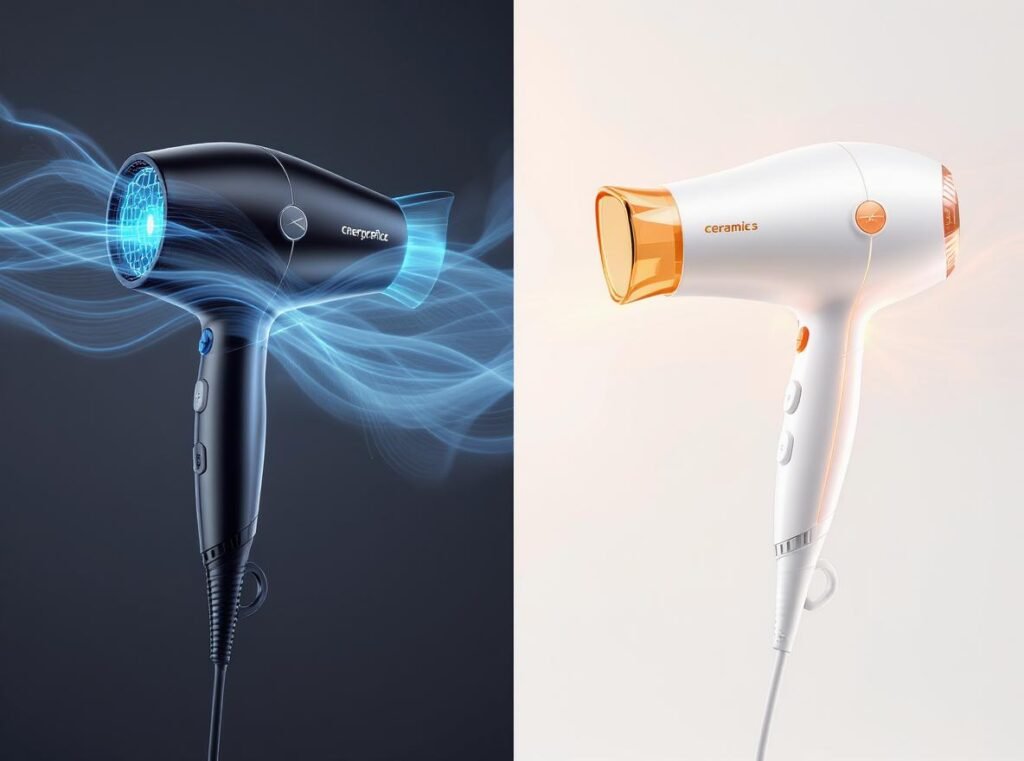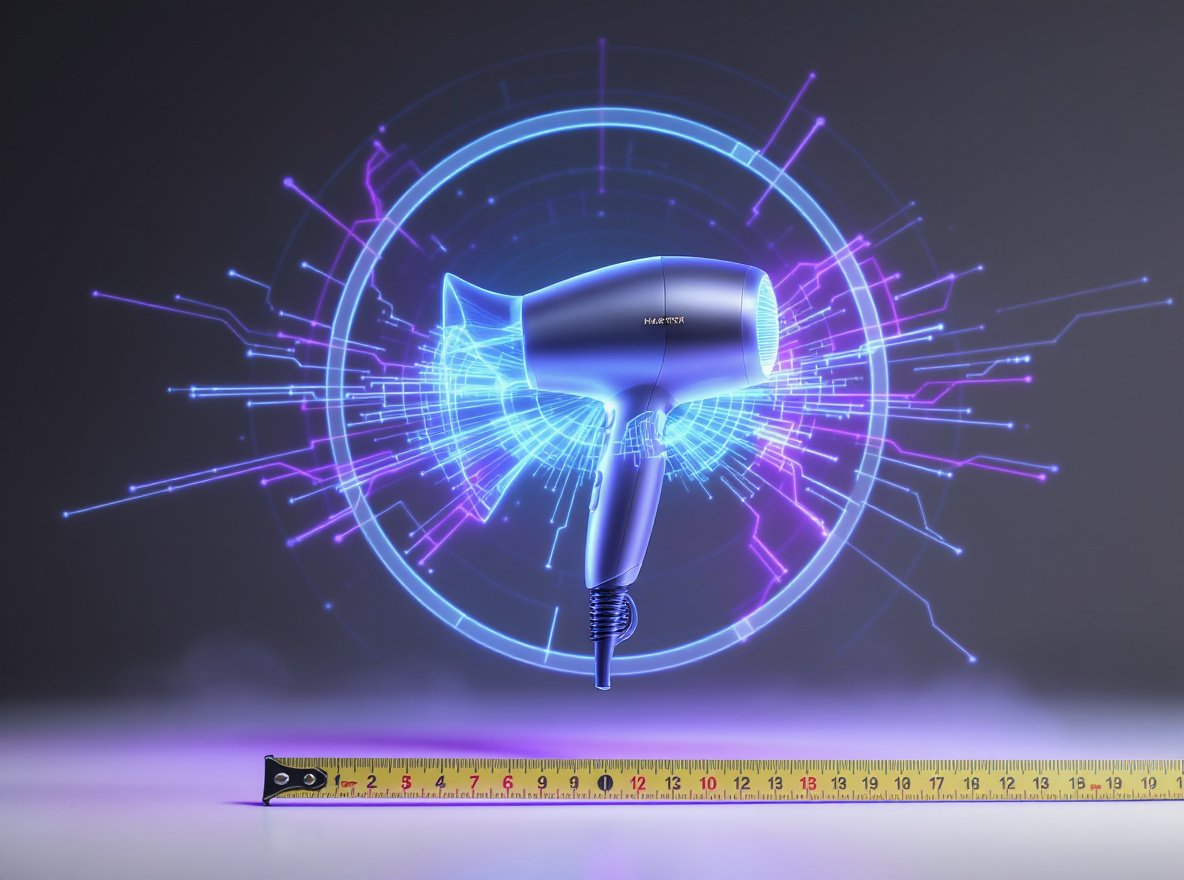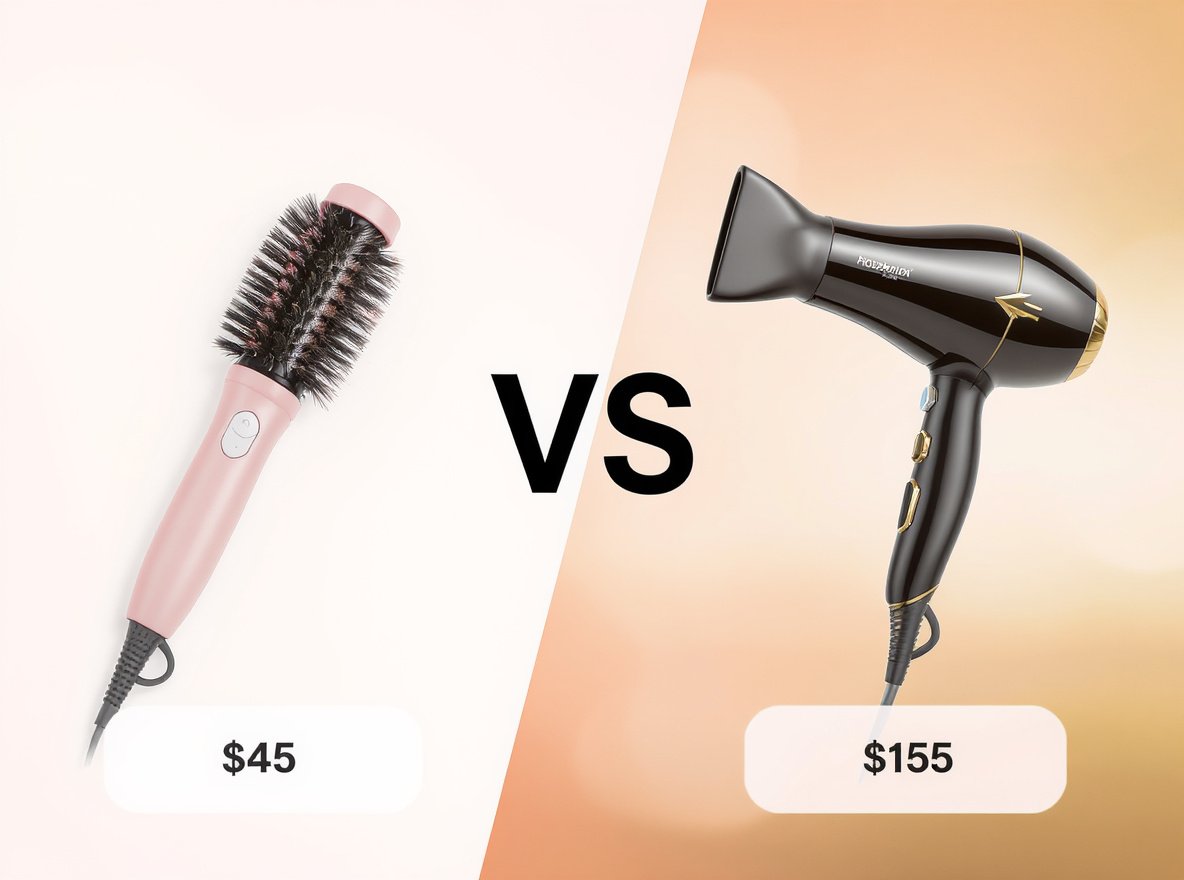Choosing the right hair dryer technology can transform your styling routine, but with ionic and ceramic options flooding the market, many wholesale buyers and retailers struggle to understand which technology delivers better results for their customers.
The choice between ionic and ceramic hair dryers depends on your customers’ hair types and styling needs. Ionic dryers excel at reducing frizz and speeding up drying time for thick, coarse hair, while ceramic dryers provide gentler, more even heat distribution ideal for fine or damaged hair.
Let’s dive deeper into the key differences to help you make the right wholesale purchasing decisions for your business.
Table of Contents
ToggleWhat Exactly Is an Ionic Hair Dryer?
Understanding ionic technology is crucial for retailers looking to educate their customers about advanced hair care solutions.
Ionic hair dryers emit negative ions that break down water molecules into smaller particles, allowing hair to dry faster while reducing frizz and static. This technology is particularly effective for thick, coarse, or naturally frizzy hair types.
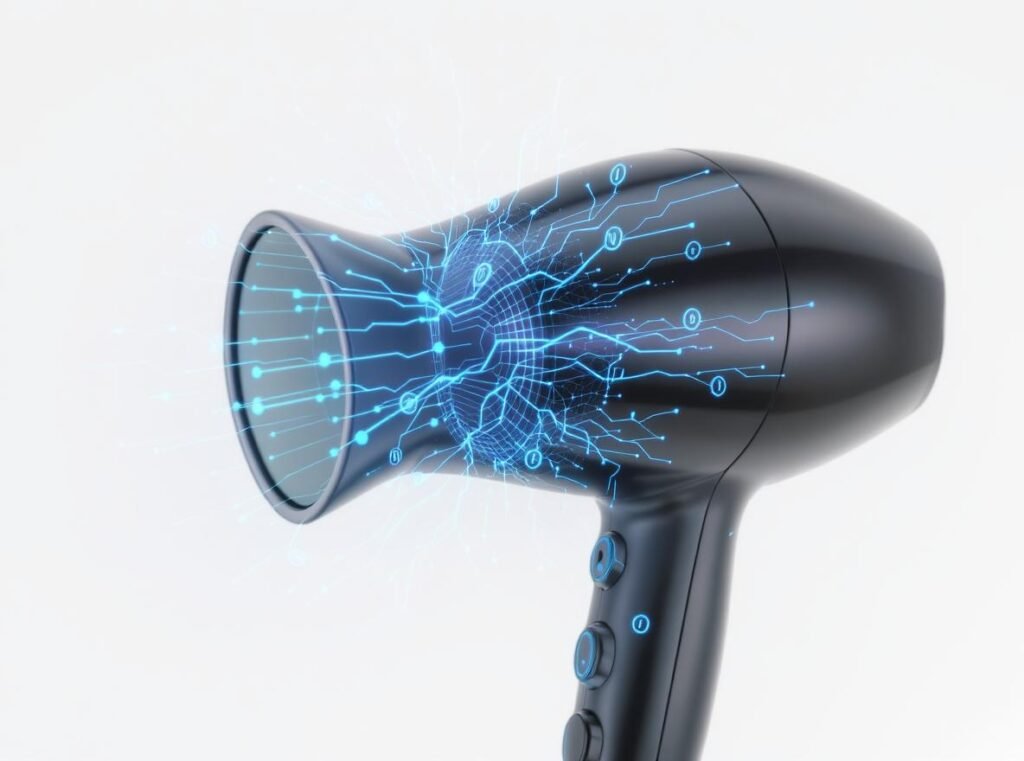
Ionic hair dryers work by emitting negative ions that break down water molecules on wet hair, causing them to evaporate faster. This process significantly speeds up drying time and helps hair remain healthier by reducing overall heat exposure. The negative ions also neutralize static electricity, close the hair cuticle, and lock in moisture.
The science behind ionic technology creates several key benefits:
- Faster drying times – Reduces styling time by breaking down water molecules more efficiently
- Frizz reduction – Negative ions neutralize positive charges that cause frizz
- Enhanced shine – Closed cuticles create a smoother, more reflective surface
- Static elimination – Prevents flyaways and unruly hair texture
| Hair Characteristic | Ionic Benefit | Customer Appeal |
|---|---|---|
| Thick/Coarse | 30-50% faster drying | Time-saving convenience |
| Frizzy/Unruly | Significant frizz control | Professional-looking results |
| Static-prone | Complete static elimination | All-weather performance |
| Long hair | Reduced heat exposure time | Hair health protection |
The technology works by neutralizing positive charges in wet hair that naturally repel each other and cause frizz. This makes ionic dryers particularly beneficial for customers with thick, coarse, or frizzy hair who struggle with traditional drying methods.
How Do Ceramic Hair Dryers Work?
Ceramic technology represents a gentler approach to hair drying that appeals to health-conscious consumers and those with sensitive hair.
Ceramic hair dryers use ceramic heating elements or coatings to produce far-infrared heat, which penetrates the hair shaft more gently and evenly than traditional metal coils. This even heat distribution helps preserve hair’s natural moisture and reduces the risk of hot spots and heat damage.
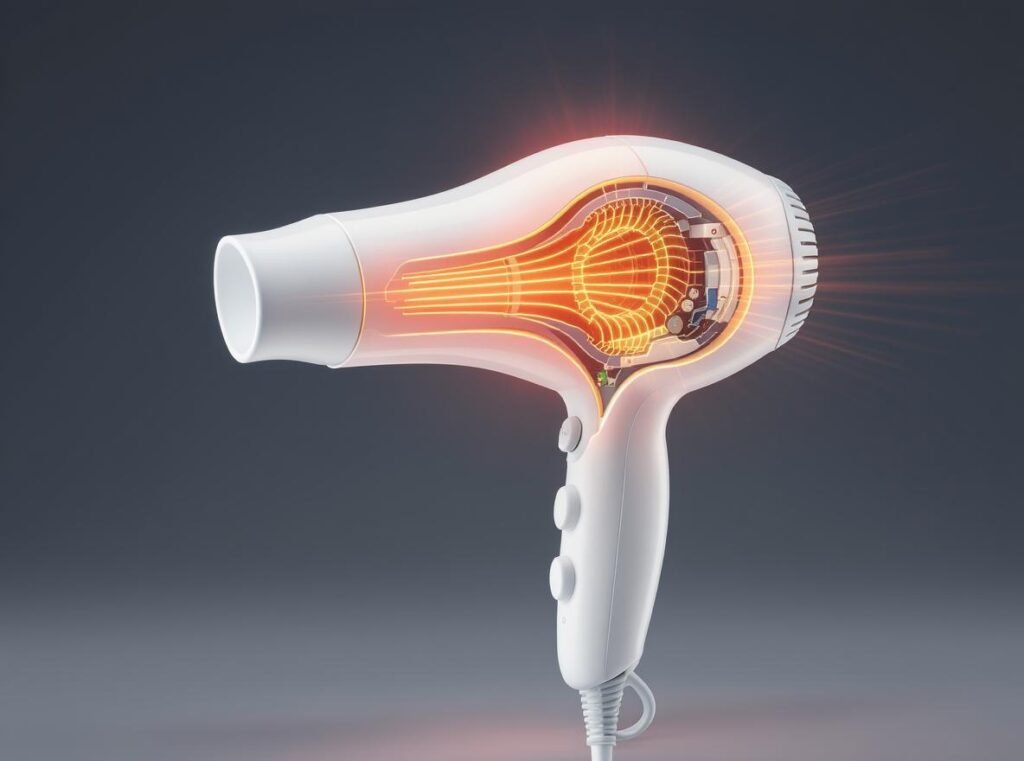
Ceramic components heat up quickly and distribute temperature evenly across the entire heating surface. The far-infrared heat produced by ceramic elements penetrates hair from the inside out, effectively reducing drying time without damaging the hair structure. This gentle approach makes ceramic dryers safe for daily use and ideal for delicate hair types.
Heat Distribution Advantages:
- Even temperature across the entire heating surface eliminates hot spots
- Consistent performance throughout the drying process
- Lower risk of overheating specific hair sections
- Maintains stable temperature regardless of airflow changes
Hair Health Protection Features:
- Far-infrared heat penetrates gently without surface damage
- Preserves natural moisture content in hair strands
- Reduces risk of cuticle lifting and protein damage
- Maintains hair’s natural texture and volume
Ceramic technology benefits nearly all hair types due to its versatile, gentle approach. The even heat distribution makes these dryers an excellent inventory choice for retailers serving diverse customer bases who prioritize hair health over maximum speed.
Which Hair Types Benefit Most from Ionic Technology?
Matching dryer technology to specific hair types ensures customer satisfaction and reduces returns for your retail business.
Ionic hair dryers work best for customers with thick, coarse, curly, or naturally frizzy hair. The negative ions effectively combat the positive charges that cause frizz and static, while faster drying time prevents over-manipulation of difficult-to-manage hair types.
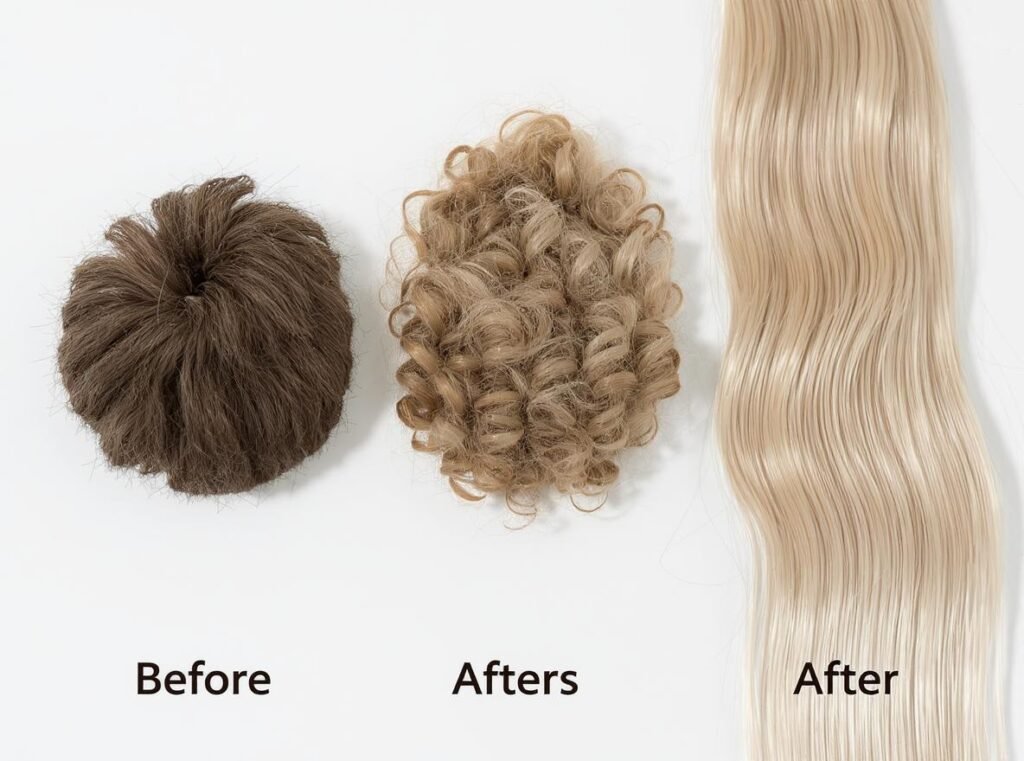
Different hair types respond uniquely to ionic technology based on their natural structure and moisture content:
Thick, Coarse, or Frizzy Hair:
Ionic dryers are ideal because they dry hair quickly, reduce frizz significantly, and enhance natural shine. The negative ions help tame unruly strands and make thick hair more manageable during styling. Thick hair contains more water and traditionally takes longer to dry, making the molecular breakdown process especially beneficial.
Curly Hair Applications:
Ionic dryers, especially when used with diffuser attachments, help define curl patterns while minimizing frizz and static. The technology preserves natural curl formation while reducing the chaos that often accompanies air-drying curly hair.
Time-Conscious Customers:
Anyone seeking to reduce their drying time will benefit significantly from ionic technology. This appeals particularly to busy professionals, parents, or salon clients who value efficiency without compromising results.
| Hair Type | Ionic Effectiveness | Primary Benefit | Professional Appeal |
|---|---|---|---|
| Thick hair | Excellent | 40-50% faster drying | High client throughput |
| Coarse hair | Outstanding | Dramatic frizz reduction | Premium service results |
| Curly hair | Very good | Enhanced curl definition | Specialized styling capability |
| Long hair | Excellent | Reduced heat exposure | Hair health maintenance |
However, ionic technology may overwhelm fine or thin hair, potentially removing too much moisture and causing limpness. Understanding these limitations helps retailers make appropriate recommendations.
When Should You Recommend Ceramic Hair Dryers?
Understanding when ceramic technology provides superior results helps retailers make appropriate recommendations and increase customer satisfaction.
Ceramic hair dryers are ideal for customers with fine, thin, damaged, or chemically-treated hair. The gentle, consistent heat minimizes the risk of overheating and breakage while being less likely to overdry or damage delicate hair structures.
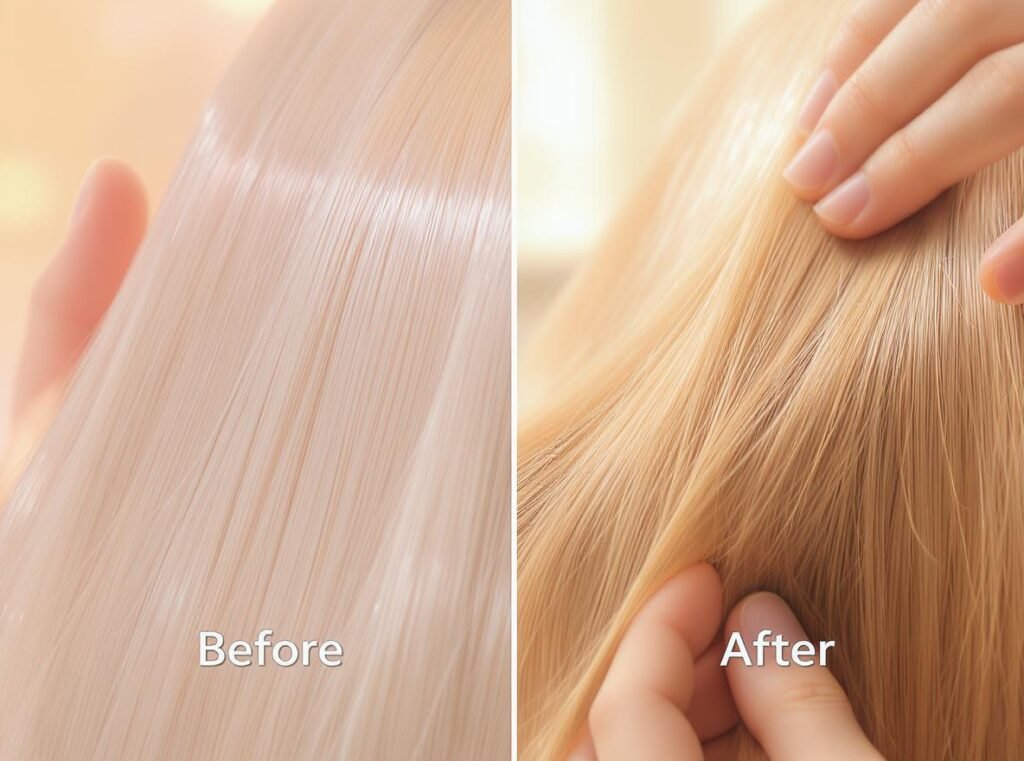
Fine, Thin, or Damaged Hair Considerations:
Ceramic dryers provide gentler heat that minimizes the risk of overheating and breakage. They’re significantly less likely to overdry or damage delicate hair, making them the safer choice for vulnerable hair types. The controlled heat helps maintain natural volume without flattening fine strands.
Heat-Sensitive or Color-Treated Hair:
The gentle, consistent heat helps maintain hair health and color integrity over time. Ceramic technology prevents the aggressive heat spikes that can cause color fading or chemical process reversal in treated hair.
Budget-Conscious Market Segment:
Ceramic dryers are typically more affordable than ionic models, making them accessible to price-sensitive customers while still offering professional-grade performance improvements over basic dryers.
Professional Salon Applications:
For stylists working with diverse clientele, ceramic dryers provide safe, predictable results that won’t surprise or disappoint clients with unexpected texture changes or heat damage.
Daily Use Scenarios:
Customers who style their hair frequently benefit from ceramic’s sustainable heat levels that won’t cause cumulative damage over time. This makes them perfect for:
- Professional salon environments requiring consistent results
- Customers who wash and style daily
- Those recovering from previous heat damage
- People with naturally delicate or aging hair
The gentler approach of ceramic technology makes it an essential option for serving customers who prioritize hair health over maximum speed.
Can You Get Both Technologies in One Hair Dryer?
Modern hair dryer innovation has led to hybrid models that combine multiple technologies, offering retailers premium products with broader customer appeal.
Yes, many modern hair dryers combine both ceramic and ionic technologies. These hybrid models offer the benefits of even, gentle heat from ceramic components plus frizz reduction and faster drying from ionic generation, making them versatile for a wide range of hair types and styling needs.
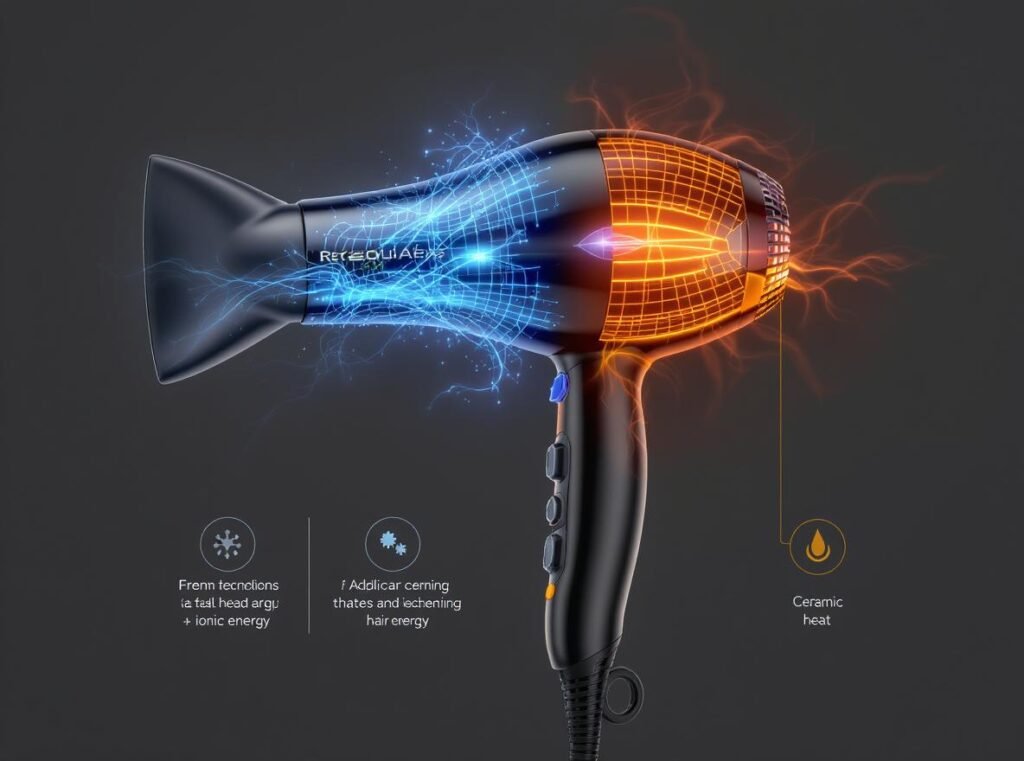
Technology Integration Benefits:
Hybrid dryers deliver comprehensive solutions by combining ceramic heating elements for even temperature distribution with ionic generators for enhanced performance. This combination approach maximizes benefits while minimizing the limitations of single-technology models.
Advanced Feature Integration:
- Ceramic elements ensure consistent, gentle heat distribution
- Ionic generators add frizz-fighting capability and speed
- Tourmaline coatings can enhance both technologies simultaneously
- Multiple heat and speed settings accommodate different hair needs
- Smart temperature controls prevent overheating
Market Positioning Advantages:
These combination models typically command higher prices and profit margins while providing comprehensive solutions that eliminate the need to stock multiple specialized dryer types. They appeal to quality-conscious customers seeking professional-grade versatility.
Customer Value Proposition:
Hybrid dryers work exceptionally well for households with multiple hair types or salons serving diverse clientele. They provide investment protection by adapting to changing hair conditions or family needs over time.
| Technology Combination | Primary Benefit | Target Market | Price Premium |
|---|---|---|---|
| Ionic + Ceramic | Balanced versatility | General consumers | 25-40% |
| Ionic + Tourmaline | Maximum frizz control | Curly/coarse hair specialists | 30-50% |
| Ceramic + Tourmaline | Gentle with shine enhancement | Fine/damaged hair focus | 20-35% |
| Triple technology | Complete solution | Professional/luxury market | 40-60% |
For wholesale buyers, models like the Conason P1C exemplify this hybrid approach, combining ionic technology with ceramic components for versatile performance that appeals to the broadest possible customer base.
How Do Drying Times Compare Between Technologies?
Drying speed directly impacts customer satisfaction and influences purchasing decisions, making it a crucial factor for retailers to understand and communicate effectively.
Ionic dryers generally offer the fastest drying times because they break down water molecules more efficiently, while ceramic dryers are slightly slower but still faster than traditional dryers thanks to their superior heat distribution technology.
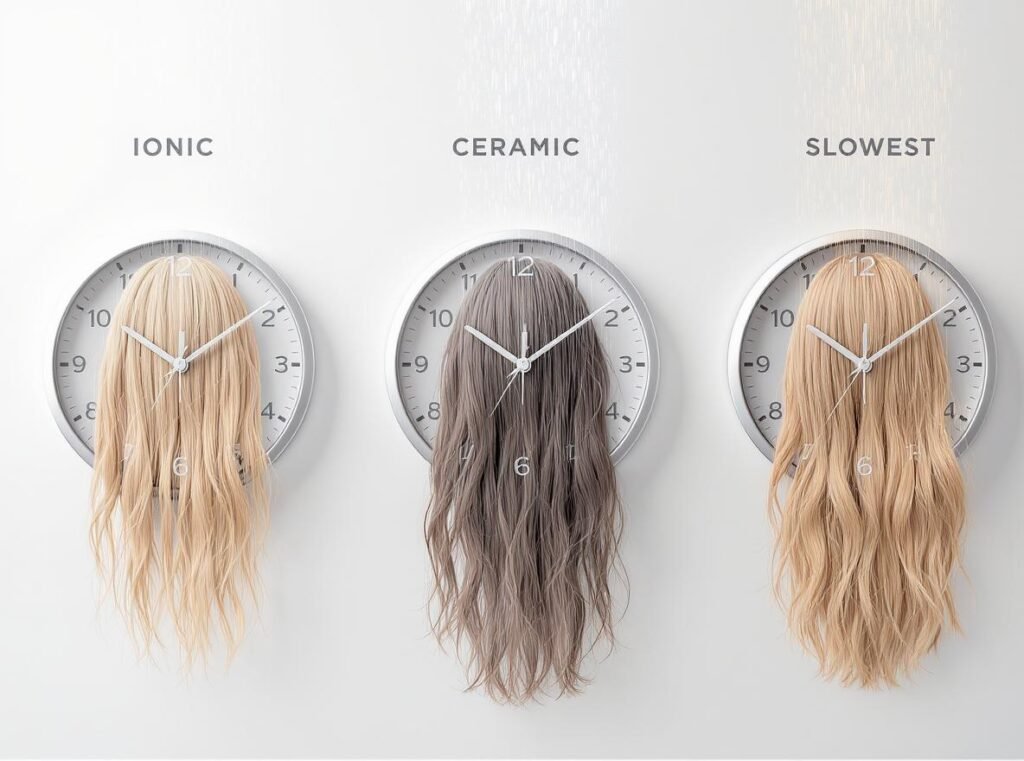
Speed Performance Analysis:
Ionic technology’s molecular breakdown process creates smaller water particles that evaporate significantly more quickly than conventional methods. This speed advantage appeals strongly to busy customers and professional stylists working under time constraints where efficiency directly impacts profitability.
Comparative Drying Performance:
- Ionic dryers: Fastest drying times due to efficient water molecule breakdown
- Ceramic dryers: Moderate speed but consistent performance throughout the process
- Hybrid models: Near-ionic speed with ceramic’s gentle consistency
Factors Affecting Drying Speed:
Professional results depend on multiple variables beyond just technology choice:
- Hair thickness, length, and natural porosity levels
- Environmental humidity and ambient temperature
- Dryer wattage, motor power, and airflow design
- User technique, sectioning method, and styling experience
Professional Time Management:
In salon environments, faster drying times translate directly to increased client throughput and higher revenue potential. Ionic dryers allow stylists to serve more customers per day while maintaining quality results, making them valuable business investments.
| Hair Length | Ionic Drying Time | Ceramic Drying Time | Traditional Dryer | Time Savings |
|---|---|---|---|---|
| Short (chin-length) | 3-5 minutes | 5-7 minutes | 8-12 minutes | 40-60% vs traditional |
| Medium (shoulder-length) | 6-10 minutes | 8-12 minutes | 15-20 minutes | 33-50% vs traditional |
| Long (past shoulders) | 12-18 minutes | 15-22 minutes | 25-35 minutes | 25-40% vs traditional |
However, faster isn’t always optimal for every situation. Speed must be balanced with hair health considerations and individual styling needs.
What About Price Differences and Value?
Understanding cost implications helps retailers position products appropriately and set realistic customer expectations for different technology investment levels.
Ionic dryers are usually more expensive due to their advanced technology and added benefits like frizz reduction and faster drying, while ceramic dryers tend to be more budget-friendly. Hybrid models may carry a premium price but deliver broader benefits that can justify the investment.
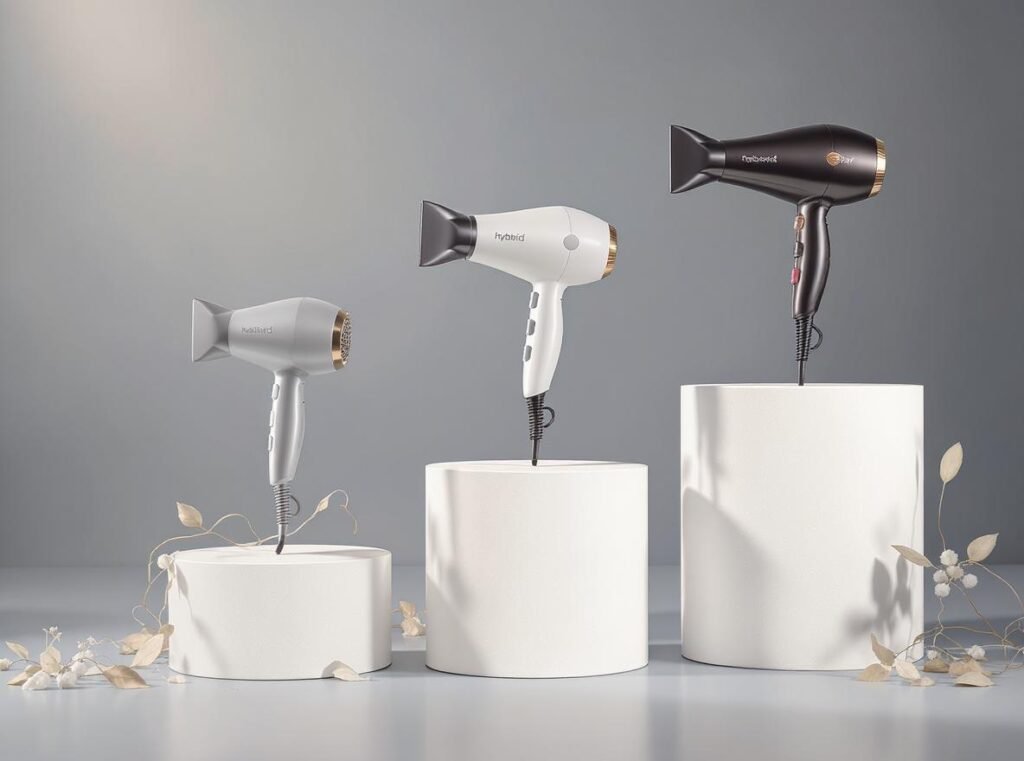
Price Structure Analysis:
The cost differences reflect manufacturing complexity, research and development investment, and market positioning strategies. Ionic hair dryers typically cost more due to the sophisticated ion generation technology and additional components required for optimal performance.
Value Proposition Factors:
- Technology sophistication: Ion generators require precise engineering and quality control
- Manufacturing complexity: Multiple heating elements and electronic components increase production costs
- Brand positioning: Premium features support higher margin positioning
- Feature integration: Advanced controls, multiple settings, and accessories add value
- Warranty coverage: Higher-quality components support longer warranty periods
Market Segmentation Strategy:
- Ceramic dryers: Entry-level professional market with solid performance
- Ionic dryers: Mid-to-premium segment focusing on advanced benefits
- Hybrid models: Premium positioning with comprehensive feature sets
Customer Investment Justification:
Higher-priced ionic and hybrid models often provide better profit margins for retailers while appealing to quality-conscious customers willing to invest in superior technology and long-term hair health benefits.
| Technology Type | Typical Price Range | Retailer Margin | Customer Value Perception |
|---|---|---|---|
| Basic Ceramic | $25-50 | 35-45% | Budget-conscious value |
| Standard Ionic | $45-85 | 40-50% | Performance-focused quality |
| Premium Hybrid | $70-150 | 45-60% | Professional/luxury investment |
| Professional Grade | $120-300 | 50-65% | Salon-quality home use |
For wholesale buyers, investing in quality hybrid models like the Conason P1C provides excellent value through competitive wholesale pricing, comprehensive technology integration, and strong customer satisfaction rates that drive repeat business.
Which Technology Offers Better Long-term Hair Health?
Hair health impact influences customer loyalty and repeat purchases, making it essential for retailers to understand and communicate the long-term benefits of each technology approach.
Both technologies offer significant hair health benefits, but in different ways. Ionic dryers provide less heat exposure and reduced frizz for healthier hair over time, while ceramic dryers offer even, gentle heat that’s especially important for maintaining the health of fine, thin, or damaged hair. Hybrid dryers maximize protection by combining both approaches.
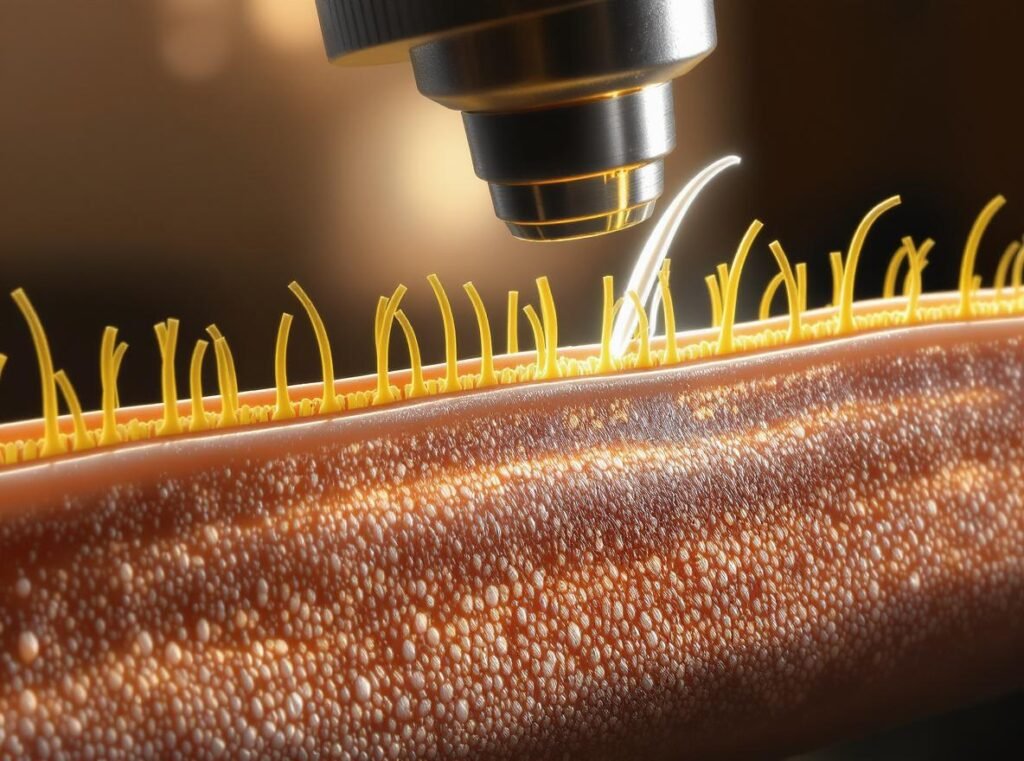
Damage Prevention Strategies:
Each technology addresses hair health through different mechanisms, making them suitable for various hair conditions and customer priorities.
Ionic Technology Health Benefits:
- Reduced heat exposure: Faster drying means less cumulative heat damage over time
- Frizz prevention: Smooth cuticles resist environmental damage and moisture loss
- Static elimination: Prevents mechanical damage from static-induced tangles
- Moisture retention: Sealed cuticles lock in natural oils and hydration
Ceramic Technology Advantages:
- Even heat distribution: Eliminates hot spots that cause localized protein damage
- Gentle processing: Lower risk of cuticle lifting and structural damage
- Consistent temperature: Prevents heat spikes that can cause irreversible damage
- Natural moisture preservation: Far-infrared heat maintains hair’s internal moisture balance
Professional Hair Health Considerations:
Many hair professionals recommend rotating between technologies or using hybrid models that allow customers to adjust settings based on their hair’s current condition and seasonal changes.
Long-term Hair Condition Factors:
- Frequency of heat styling and environmental exposure
- Natural hair porosity, texture, and genetic factors
- Use of heat protectant products and professional treatments
- Overall hair care routine quality and product selection
| Hair Condition | Ionic Benefits | Ceramic Benefits | Hybrid Advantages |
|---|---|---|---|
| Healthy hair | Speed and shine | Gentle maintenance | Comprehensive protection |
| Damaged hair | Reduced processing time | Gentle restoration | Adaptive care options |
| Color-treated | Sealed color protection | Heat-safe processing | Optimal color longevity |
| Chemically processed | Quick, gentle drying | Controlled heat application | Customized treatment approach |
The key to optimal hair health lies in matching technology to individual needs and allowing flexibility to adapt as hair condition changes over time.
How to Choose the Right Technology for Your Inventory?
Strategic inventory decisions impact sales success, customer satisfaction, and business profitability in the competitive hair care market.
Consider your client hair types, budget range, and need for versatility. Stock more ionic or hybrid dryers if your clientele has thick, curly, or frizzy hair; prioritize ceramic for fine or damaged hair. Hybrid dryers provide the most flexibility for professional or retail environments serving varied hair needs.
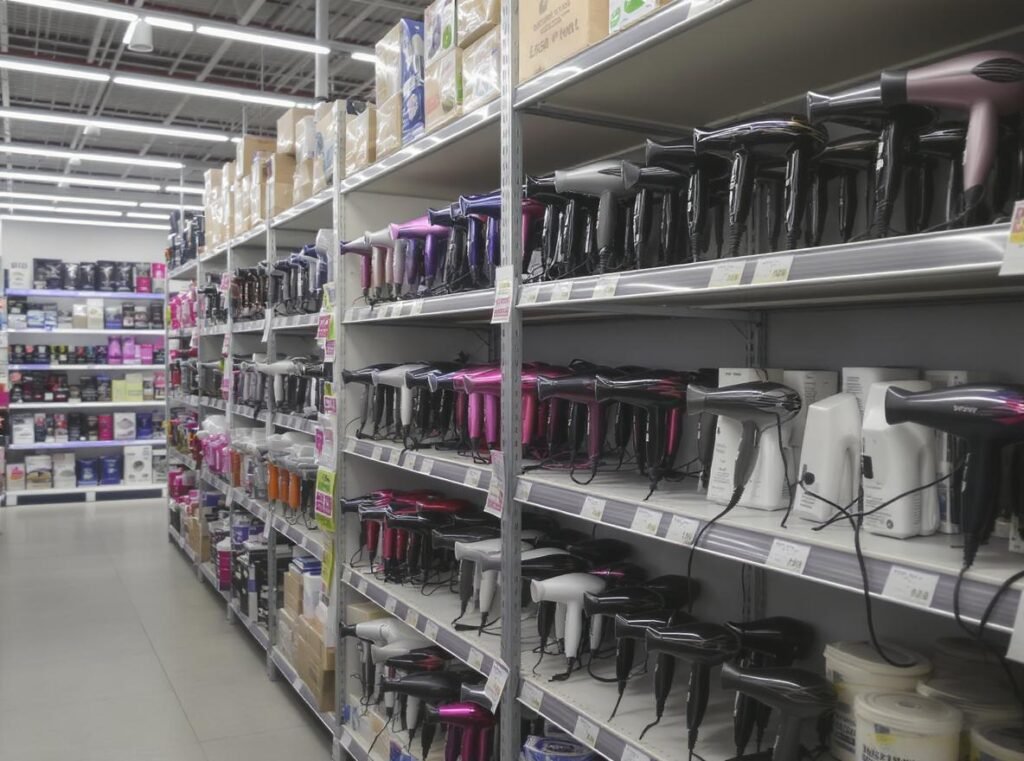
Market Analysis Framework:
Understanding your customer demographics and buying patterns determines optimal inventory allocation strategies. Successful retailers balance technology variety with inventory efficiency.
Customer Segmentation Strategy:
- Client hair type analysis: Survey or observe predominant hair characteristics in your market
- Budget range assessment: Understand price sensitivity and spending patterns
- Usage pattern evaluation: Determine whether customers prioritize speed versus gentleness
- Professional versus consumer focus: Different markets require different technology emphasis
Inventory Allocation Guidelines:
Based on market research and customer feedback patterns:
- 40% hybrid models: Broad appeal and versatility for diverse customer base
- 30% ceramic models: Essential for sensitive hair and budget-conscious segments
- 20% ionic models: Specialized solutions for specific frizz and speed needs
- 10% premium/specialty: Luxury segment and professional-grade applications
Customer Education Investment:
Knowledgeable staff and clear product information help customers choose appropriate technology, significantly reducing returns and increasing satisfaction levels. Consider providing:
Educational Support Materials:
- Hair type identification guides with visual examples
- Technology comparison charts highlighting key differences
- Usage technique recommendations for optimal results
- Maintenance and care instructions for longevity
Professional Partnership Opportunities:
Some successful retailers offer brief consultations or partner with local stylists to help customers select appropriate dryer technology, building relationships that justify premium pricing and encourage customer loyalty.
| Business Type | Recommended Technology Focus | Key Success Factors |
|---|---|---|
| General retail | Hybrid models (50%) + Ceramic (35%) | Broad customer education |
| Salon supply | Ionic (45%) + Hybrid (35%) | Speed and professional results |
| Beauty specialty | Ceramic (40%) + Premium hybrid (40%) | Hair health expertise |
| Online wholesale | Balanced full range | Comprehensive product information |
Quality Partnership Considerations:
Partner with manufacturers like Conason that demonstrate expertise in combining multiple technologies effectively. The P1C model exemplifies successful hybrid engineering with ionic generation, ceramic components, and intelligent heat control systems that deliver consistent customer satisfaction.
Summary
Choosing between ionic and ceramic hair dryer technology requires understanding your customers’ specific hair types, styling priorities, and budget considerations. Ionic dryers excel at reducing frizz and achieving faster drying times for thick, coarse hair, while ceramic dryers provide gentler, more controlled heat distribution ideal for fine or damaged hair. Modern hybrid models combining both technologies offer the greatest versatility for retailers serving diverse markets and represent the best investment for comprehensive customer satisfaction.
Ready to enhance your hair dryer inventory with cutting-edge technology? Explore our complete collection of professional-grade hybrid dryers at Conason Products or discover the innovative P1C high-speed hair dryer that combines ionic and ceramic technologies for superior customer results. Contact us today to discuss wholesale pricing and inventory solutions that drive your business success.

